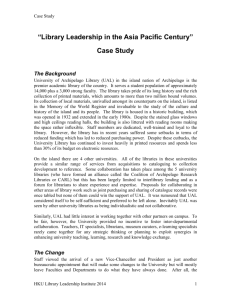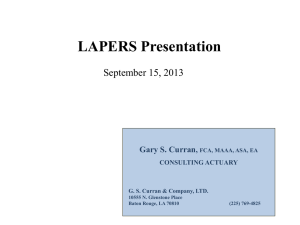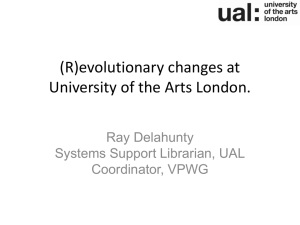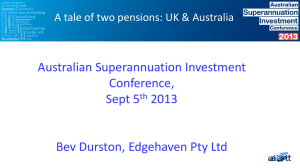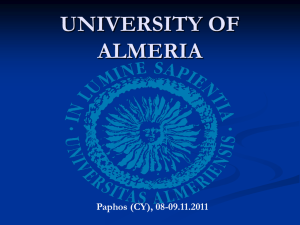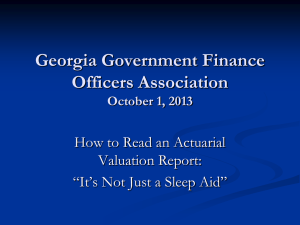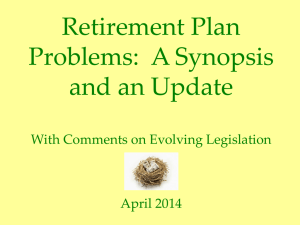Pension Basics - AFSCMEStaff.org
advertisement
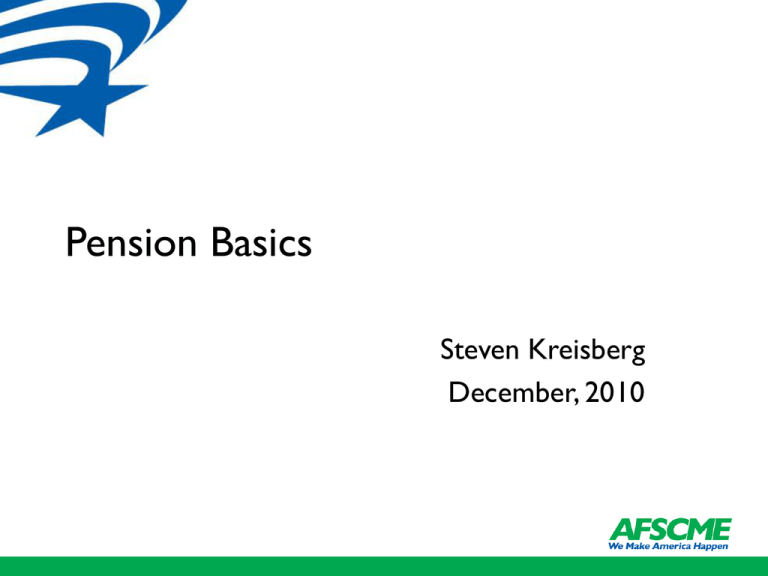
Pension Basics Steven Kreisberg December, 2010 What is a pension? • Deferred compensation: earned benefit for services rendered • Benefit is defined based on a formula – “Multiplier” – Years of Service – Final Average Salary • Benefit is based on “normal” retirement age – combination of age and years of service Pension Formula • 25 years of service, “multiplier” of 2% and FAS of $40,000 • $40,000 x 2% x 25 = $20,000 • Reductions for survivor annuity • Reductions for retirement prior to “normal” age • Post-retirement COLAs How much does a benefit cost? • Pre-funding a benefit that is decades away from payment requires assumptions • Theory: the cost of the plan is spread out over each participant’s career to provide payments over a lifetime • Normal cost: the cost of the benefits earned in the current year. Normal Cost (Service Cost) • Actuarial present value of benefits accrued in the year. • Pension costs are paid over the life of an employee’s career. With investment, the assets should pay for a lifetime annuity. • Normal cost usually is a percent of payroll Critical role of assumptions • Economic Assumptions: How will market forces affect the cost of the plan? • Demographic Assumptions: How will participant behavior affect the cost of the plan? Economic Assumptions • Interest Rate or assumed return on investment. This also leads to the discount rate for pension accounting. • Salary assumption: projecting an individual’s pay growth in the future. • Inflation: Nominal versus real returns. COLAs. Demographic Assumptions • Withdrawal assumptions: length of service and turnover • Mortality • Retirement assumptions (age and service) • Disability assumptions Assumptions versus Reality • Assumptions should be accurate in long term • In short term, expect deviations • Investment earning are most volatile – Smoothing of deviations • Deviations can lead to greater or reduced funding Unfunded Actuarial Liabilities (UAL) Unfunded Actuarial Liabilities Two components: prior service and actuarial gains/losses • Prior Service Liability: costs for service already performed stemming from failure to fund normal costs or retroactive benefit improvements. • Actuarial gains/loses: Experience deviates from assumptions. Investment gains/loses are largest component but mortality, salary growth, retirement, turnover, etc. can deviate as well. • UAL can be amortized over 30 years Accounting meets funding: Annual Required Contribution • ARC is not “required” but is the amount necessary to bring plan to full funding over amortization period • ARC = normal cost + amortization of UAL + admin • Currently, UAL costs equal or exceed normal cost for many plans ARC Components Employee Contribution Employer Normal Cost Employer UAL Ohio State 10% (09) Ohio Local 10% (09) Colorado (08) 8.05% 4.89% 3.6% 4.46% 4.04% 5.4% 7.35% Minnesota (09) 4.75% 3.11% 6.99% LACERS (1011) 9.8% 8.51% 6% Pennsylvania Schools – Projected Contributions ER Normal UAL Total 2011 8.08% -.50 7.58% 2012 8.02% 1.85% 9.87% 2013 8.00% 20.50% 28.50% 2014 7.96% 23.42% 31.38% 2015 7.93% 24.97% 32.90% 2016 7.91% 24.68% 32.59% 2017 7.89% 24.18% 32.07% Things may be bad… But they’re not getting better • Investment loses have been smoothed Pennsylvania School Employees – 5 year average Our “Fight” is Over Debt • Employer Normal Cost payments are not excessive • Rising plan costs are due to UAL • UAL remains even if plan is closed Basis for the Attacks • The problem is real…and deep • But the right is distorting the numbers to make it look worse • The attack is broad, but each case is different • Our opponents offer “Solutions that Fail” “Solutions” that fail • New tiers • DC conversion • Anything that doesn’t affect UAL Solutions that hurt • Contribution increases • Limit or eliminate COLAs • Increase retirement age • Changes to FAS – career average • Decrease in multiplier • Increasing vesting periods The Solution: Pay Up! • Normal Cost • Interest on UAAL • ARC 30 year amortization “open” vs. “closed” The Attack - Distorting the numbers: The Discount Rate Controversy • Practice: Discount rate = assumed ROI (GASB) • Claim: discount rate should reflect risk free investment. (20 year T-Bill = 4%) Investment Assumption: Small Change = Big Impact Rebutting the Discount Rate Heretics Their assumptions are not supported by practice GASB specifically rejected the “risk free” approach Historical investment returns exceed the typically assumed 4.5% real rate Long term horizon is more appropriate than snapshot that has been distorted by 2008/9 experience “Risk free” portfolios raise taxpayer expense The Attack: Pensions are bankrupting us • All pensions and politics are “local” • In aggregate: pensions 3.8% of state/local spending • Expected to rise to 5% by 2014 • The discount rate/investment assumption discussion matters • Pension contributions can ramp up as revenues recover Pension funds are not the source of budget problems • • • • • • UAL can be amortized over 30 years Normal cost vs. Total cost Total cost as percentage of all expenditures Investment return assumptions No federal bailout Foregone Employer contributions The Attack: Pensions are too rich • Average benefit is $19,000 per year • Members typically contribute 3% to 8% of pay • State and local government employee total compensation trails private sector by 7% to 7.5% • Some public employees are not covered by Social Security Spiking, DROP, Double Dipping Early Retirement • Spiking and double dipping are not a major funding issue, but they incite anger • DROP creates deviations from actuarial expectations on retirement (behavior change) and big cash payouts • Early retirement reductions: actuarial vs. smaller “penalty” • Reclassification issues Defined Benefit v. Defined Contribution • Pensions more efficient than 401k • 401(k)’s: a failed experiment – $6.6 trillion savings deficit • DC will add costs in the short term – Compare proposed cost of DC/hybrid to normal cost • DC does not address UAL Can progressives support pensions? “I think it’s great to say how we should exact more from corporations and banks and rail against capitalism. But in the absence of an immediate source of funding for these pension mandates, services for needier workers and the unemployed will be eliminated. That’s a reality.” Matt Gonzales, former SF City Council President
